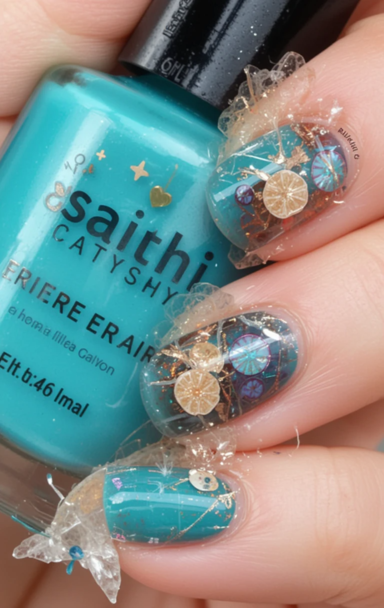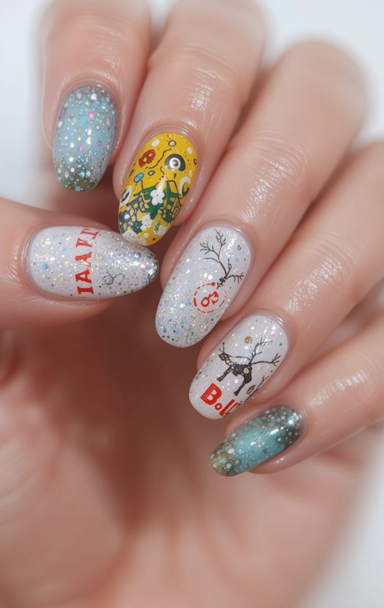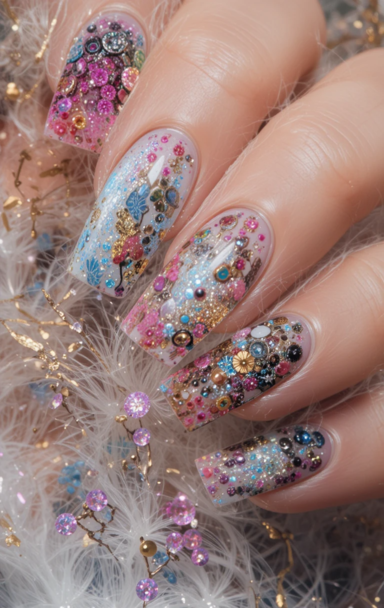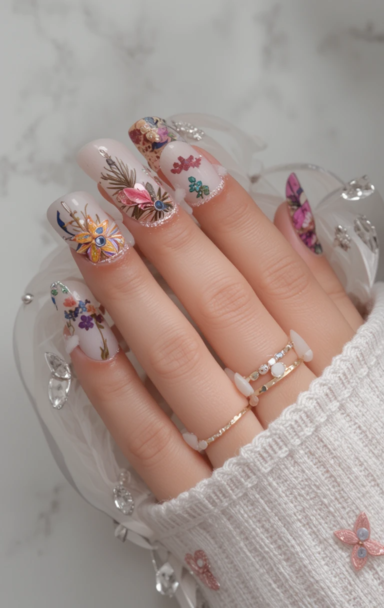Nail art has evolved far beyond the simple application of polish. It has become an international form of self-expression, a cultural statement, and a creative canvas that reflects the beauty, history, and identity of various cultures worldwide. In recent years, nail fashion has transcended geographical borders, blending influences from diverse regions and traditions, resulting in an ever-evolving, globally-inspired beauty trend. Whether it’s the meticulous art of Japanese nail design, the vibrant colors of African nail culture, or the minimalistic Scandinavian aesthetics, each cultural influence offers unique approaches that elevate the manicure from a simple beauty routine to an art form.

This article explores the cultural influences that shape nail fashion, examining global trends and offering inspiration from various parts of the world that will help you discover new ways to style your nails.
The Evolution of Nail Art Across Cultures
Nail art is an ancient tradition that can be traced back thousands of years. It has been used to signify social status, personal identity, and even religious affiliation. Nail fashion has always been influenced by cultural beliefs, practices, and aesthetics, and this influence continues to grow in the modern age. From the ancient Egyptians to contemporary global trends, nail art has served as an important tool for cultural expression.

Ancient Civilizations and Nail Art
The first historical evidence of nail art comes from ancient Egypt. Both Egyptian men and women used henna to dye their nails, with darker colors symbolizing wealth and social status. The famous Queen Cleopatra was known to wear deep red nails, which signified royal status. Meanwhile, the Chinese and Indians also practiced early forms of nail art, using natural ingredients like beetles and plant-based dyes to decorate their nails. In ancient China, nail color was also a symbol of social status, with gold and silver reserved for the royals.
As time progressed, nail art became a more widespread cultural practice, adopted by various civilizations, each bringing its own interpretation and style to nail fashion. In the modern era, nail art has evolved into a global phenomenon, with influences from cultures around the world blending together to create the vibrant, creative expressions seen today.

Key Cultural Influences in Nail Fashion
Nail fashion has taken inspiration from various cultures, with different regions contributing to global trends in unique ways. Let’s take a closer look at some of the key cultural influences that have shaped modern nail trends.

1. Japanese Nail Art (Kawaii Culture and Precision)
Japanese nail art has gained worldwide recognition for its intricate designs, bold colors, and elaborate embellishments. It is an art form that emphasizes kawaii culture—a Japanese term meaning “cute” or “adorable”—which is reflected in many nail art trends, such as 3D designs, glitter, and cartoon-inspired nails.
The practice of decorating nails with small accessories such as rhinestones, gems, flowers, and bows is a hallmark of Japanese nail art. Kawaii nails often feature delicate designs like Hello Kitty, anime characters, or floral patterns, creating a youthful, playful aesthetic that appeals to many.
In addition to the playful and fun side of Japanese nail art, there is also a more sophisticated side known as “gyaru nails”—a style popularized by the gyaru subculture in Japan. This look involves using vibrant colors, dramatic stiletto nails, and gold accents. The designs may include crystals, metallic finishes, and bold patterns, all while maintaining a high level of precision.
Japanese nail artists are also known for their ability to create extremely detailed and intricate designs that reflect an almost sculptural level of craftsmanship. This attention to detail makes Japanese nails one of the most technically advanced forms of nail art in the world.
2. African Nail Art (Bold Colors and Cultural Expression)
African cultures have long utilized color symbolism, intricate patterns, and textures in their art, and these elements have translated beautifully into nail fashion. Nail art in Africa often incorporates bright, vibrant hues and symbolic designs inspired by African traditions, beliefs, and artistic expressions.
In African nail fashion, colors like gold, red, green, yellow, and black dominate, often representing various cultural values. For example, red can signify passion, green symbolizes fertility, and gold often reflects royalty or wealth. Nail designs in Africa frequently include tribal patterns, geometric shapes, and hand-painted designs, sometimes paying homage to the ethnic groups and their distinct styles.
A trend that has gained popularity in the West is African tribal prints, which translate well onto nails. These designs are often detailed, bold, and graphic, incorporating geometric shapes, lines, and dots in a way that mimics traditional body art. African-inspired nail art often takes inspiration from fabrics such as kente cloth or ankara, which feature bold, geometric patterns that are often mirrored on the nails.
In addition to intricate designs, nail piercings and decorative accessories like beads or metal accents are also popular in African-inspired nail fashion. These accessories make the nails stand out even further and bring a sense of uniqueness and cultural pride to the manicure.
3. Scandinavian Nail Art (Minimalism and Natural Beauty)
In contrast to the bold and colorful designs seen in other parts of the world, Scandinavian nail art is often characterized by minimalism, natural tones, and simple elegance. Scandinavia—comprising countries like Sweden, Denmark, Norway, and Finland—has a long history of clean lines and understated beauty, and these principles are reflected in Scandinavian nail designs.
The “less is more” approach is a cornerstone of Scandinavian aesthetics. Neutral colors such as white, gray, beige, and pastel hues are popular choices for nail color. Rather than elaborate designs, the focus is often on clean, simple shapes such as half-moons, negative space nails, and minimalist dots or lines.
Nail care is also important in Scandinavian culture, where the emphasis is placed on healthy, natural nails. Nail treatments, moisturizing oils, and cuticle care are an integral part of the beauty regimen. Many women in Scandinavia choose to keep their nails relatively short and well-maintained, using soft, subtle colors and simple designs to enhance the natural beauty of their hands.
This style is perfect for anyone who enjoys understated elegance and simplicity. The appeal of Scandinavian nail art lies in its timeless nature, as it can easily transition from season to season and fits effortlessly into a variety of outfits and occasions.

4. Indian Nail Art (Vibrant Colors and Intricate Designs)
In India, nail art is an extension of the rich and colorful traditions of the culture. Much like African nail fashion, Indian nail art embraces bold, vibrant colors, often inspired by the bright hues seen in traditional Indian clothing, such as saris and lehengas. Gold, red, pink, turquoise, and emerald are some of the most common colors used in Indian-inspired nail art, often paired with intricate patterns and embellishments.
A prominent feature of Indian nail art is its incorporation of henna-inspired designs. Just as henna tattoos are commonly used to decorate the skin for weddings, festivals, and other significant occasions, henna-style motifs are increasingly popular in nail art. These designs often feature paisleys, floral motifs, and mandala patterns, drawn meticulously onto the nails to create an ornate, decorative effect.
Additionally, jewels and metallic accents are commonly used in Indian nail art to add a luxurious, festive feel. Women in India often adorn their nails with tiny rhinestones, gems, and sequins to create dazzling, eye-catching looks. These embellishments are frequently seen during special occasions, like weddings and religious festivals, where nail art becomes an important part of the overall beauty and attire.
5. Middle Eastern Nail Art (Opulence and Detail)
The Middle Eastern influence on nail fashion is often centered around luxury, opulence, and intricate detail. Women from this region favor nails that are ornate, highly decorated, and full of personality. Much like the African and Indian styles, Middle Eastern nail art is characterized by bold designs, metallics, and the use of gems and jewels.
The use of gold and silver accents is prevalent in Middle Eastern-inspired designs, often in the form of metallic stripes, floral designs, or gem-studded patterns. This opulent approach is inspired by the region’s rich cultural history, where jewelry, intricate fabrics, and ornate designs have long been an essential part of personal adornment.
In addition to the luxurious elements, Middle Eastern nail art often includes Arabic calligraphy or geometric designs that reflect the region’s history in art and design. Marble-effect nails—a swirling pattern that resembles the veins of natural marble—are also popular in this culture, often done in rich tones like emerald, gold, or black.
Global Trends and How to Incorporate Cultural Nail Art Into Your Look
Global trends in nail fashion are increasingly diverse, offering a wealth of styles and designs to suit any preference. Whether you’re drawn to the minimalist charm of Scandinavian nails, the bold statement of African or Indian nail art, or the opulence of Middle Eastern-inspired designs, there is something for everyone in the world of nail fashion. Here’s how you can incorporate these cultural influences into your next manicure:
- Mix and Match Cultures: Don’t be afraid to combine elements from multiple cultures. For example, a Scandinavian-inspired minimalist design can be paired with bold, African tribal patterns for a creative fusion.
- Stay Timeless with Neutral Hues: Scandinavian and Japanese nail art both emphasize the beauty of neutral hues. Try adding subtle geometric designs or minimalist accents for a clean, modern look.
- Celebrate Festivals with Vibrant Colors: If you’re celebrating a special occasion or simply want to add some color to your nails, explore Indian or African nail art for inspiration. Use bright, rich colors and intricate designs to create a bold statement.
- Embrace Opulence: For a luxurious touch, try incorporating Middle Eastern elements such as metallic details or gemstones into your manicure for an opulent, glamorous look.
Nail art is a powerful form of personal expression, one that draws from a rich tapestry of cultural influences around the world. From the intricate designs of Japanese nails to the bold and vibrant colors of African nail fashion, each cultural approach to nail art offers a unique opportunity to explore creativity and express individuality. Whether you opt for minimalist Scandinavian elegance or the ornate designs of the Middle East, cultural nail trends can help inspire your next manicure and elevate your beauty routine to an entirely new level. So, let your nails become your canvas and take inspiration from the world’s diverse cultures to create a look that speaks to your unique sense of style.



